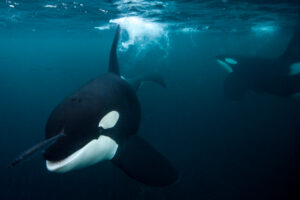Last May, a young woman came across an alien-like object on a beach in California. Squishy, dark brown, somewhat see-through, and spiral-shaped, she had found a spectacular horn shark egg. It is one of many bizarre eggs in the animal kingdom.
Horn shark egg

Horn shark egg in New South Wales, Australia. Photo: Shutterstock
Horn sharks are a type of bullhead shark. While harmless to humans, they are impressive predators with a very powerful bite, even compared to other sharks. The strong bite is necessary because their diet consists of crustaceans and hard shell marine animals.
In winter, horn sharks mate. The female begins to lay her eggs a couple of months later, releasing two eggs every two weeks. She can lay around two dozen eggs, with each measuring up to 12cm long. Light brown at first, they darken as the baby shark develops. The egg casing is made of keratin.
The spiral egg shape acts as a screw when the mother wedges the egg between rocks and tight spaces. As the egg darkens, it acts as a camouflage from potential threats.
The eggs provide everything the young need to develop. It contains a yolk sac that sustains the young shark until it emerges and can hunt on its own. The babies stay in their egg cases for up to 10 months.
Once hatched, they grow up to 61cm long and can live for 50 years.
Ghost shark egg

Ghost shark egg. Photo: Shutterstock
Ghost sharks, also known as elephant fish, are members of the Chimaera family. Chimaeras are not sharks but rather close relatives that resemble sharks. They can possess dangerous defensive adaptations, such as poisonous dorsal fins.
Ghost sharks get their name from their eerily clouded eyes, grey skin, and tendency to lurk in deep seawater. The species inhabits the southwestern Pacific. Chimaera branched off from sharks almost 400 million years ago.
In spring, ghost sharks migrate to shallow waters to mate and lay eggs. The golden eggs are 25cm long. Like horn shark eggs, the color darkens into a deep brown over time. The leathery egg case, made of keratin, resembles a spindle and contains a protective flap.
As with the horn shark, the egg case provides the embryo with a yolk to feed on until it hatches seven to eight months later.
Male and female ghost sharks vary in size. Males measure up to 50cm while females grow to 70cm.
Skate eggs

A skate egg among rocks. Photo: Shutterstock
Skates are a type of ray closely related to Chimaeras and sharks. Their reproductive processes are similar. Two skates mate and then the female finds a shallow spot to deposit the eggs.
Skate eggs resemble rectangular pillows and usually have swirly tendrils or horns at the base. Sometimes, you can see these eggs hanging by these tendrils on corals or plants. The eggs are often called “mermaid purses.”
The skate stays in its purse for 15 months before hatching. It exits through a thin slit in the purse.
Green lacewing eggs

Green lacewing egg. Photo: Shutterstock
Green lacewings are bright green insects with large wing spans of 65mm. Some people use them for pest control, buying larvae to rid their homes of mites and parasites that consume their plants.
After mating, the female lays up to 300 minuscule eggs on leaves. The eggs look like tiny white or yellow drops atop a very thin stalk. This stalk holds the egg out of reach and is vital for the egg’s survival, as other hatched larvae would otherwise eat them. Adult green lacewings feed on nectar and pollen, but their larvae feast on any insect in sight, including kin.
After gorging on mites and aphids for about three weeks, the larvae retire to a cocoon for metamorphosis. Two weeks later, they burst through the cocoon as green lacewings.
Surinam Toad

Surinam Toad eggs on the mother’s back. Photo: Dan Olsen/Shutterstock
Trypophobes might want to stop reading. Surinam Toad eggs are arguably the grossest on this list.
Native to South America, Kavita Ramdatt of the University of the West Indies describes them as “looking like road kill,” because of their flat appearance. They are also called stargazers because their eyes are on top of triangular-shaped heads. Their eggs incubate on their characteristic honeycomb skin until hatching.
In the elaborate mating process, the male attracts the female with a loud clicking. Then he mounts her and takes her into the water, where they somersault and flip around. The male then fertilizes the eggs and pushes them onto her back, where they stick to her skin.
The small eggs sit in these holes in the mother’s skin. Here, the young develop into tadpoles inside the eggs and emerge as baby toads. This process takes 12 weeks. After the birth, the mother sheds her skin and starts afresh.






